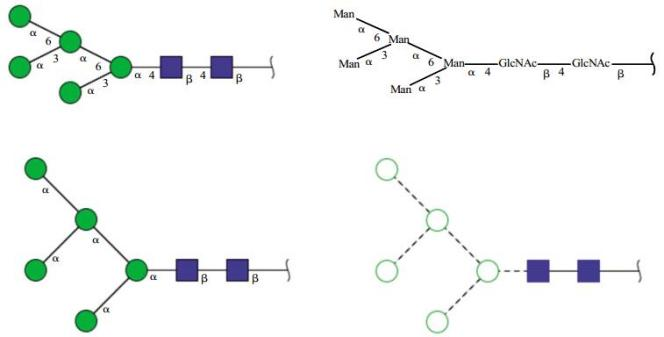Oligosaccharide Chain Structure Analysis Service
Glycosylation has significant impacts on the efficacy, stability, and immunogenicity of biological products. Among these, the oligosaccharide spectrum and oligosaccharide structure are important indicators for assessing the characteristics of biopharmaceuticals. Oligosaccharides, as important carbohydrates, participate in various cellular life processes, such as protein folding and signal transduction. In addition, oligosaccharides often bind with proteins to form glycoproteins. Glycoproteins are commonly located on the cell surface, involved in the recognition of bacteria and viruses, as well as interactions with other proteins like lectins, which are crucial for the normal function of biological products.
The synthesis of oligosaccharides is not template-driven and exhibits a dendritic structure, which adds to the complexity of analyzing oligosaccharide structures. For this purpose, MtoZ Biolabs has developed a series of stable, efficient liquid chromatography with tandem mass spectrometry (LC-MS/MS) characterization methods. These methods cover the complete analysis process from oligosaccharide analysis, glycosylation site identification, to glycopeptide resolution. Through these methods, we can effectively study and resolve the structure and functional characteristics of oligosaccharides, thereby better understanding the impact of glycosylation on biological products. The basic glycosylation analysis workflow is shown below:

Figure 1. Glycosylation Analysis Workflow
Technical Principles
The analysis of oligosaccharide chains usually employs a high-resolution MS platform coupled with LC. Initially, the oligosaccharides are cleaved from glycoproteins using PNGase F glycosidase. Subsequently, the cleaved oligosaccharides are derivatized using 2-aminobenzamide (2-AB) reagent for labeling. Once labeling is complete, the oligosaccharide samples are injected into the LC-MS platform for data acquisition. Glycan analysis software is employed to interpret the raw mass spectrometry data to determine structural details.
During the analysis process, the LC equipment is equipped with a fluorescence detector, which can be used for the quantification of oligosaccharides. At the same time, the tandem MS system is used for oligosaccharide structural analysis and identification. These analytical methods combine MS and chromatography techniques, effectively revealing the structure and characteristics of oligosaccharide chains.

Figure 2. Experimental Process
Experimental Instruments
HILIC-UHPLC/AB SCIEX 5600+
Sample Results
The analysis of N-glycans using HILIC-UHPLC-MS/MS is the mainstream method today. Hydrophilic Interaction Liquid Chromatography (HILIC) is used for the separation of N-glycans. Through the reaction with PNGase F enzyme, N-glycans are released. Subsequently, the released oligosaccharides are derivatized with 2-AB. This derivatization allows for the analysis of a large number of N-glycan samples. After derivatization, the N-glycans are detected using HILIC-UHPLC-MS. Finally, using specialized software, automatic structural analysis is performed to obtain the results. The analysis results of N-glycan types and oligosaccharide structures are displayed as follows:

Figure 3. Glycan Structures Corresponding to the N-Glycan Profiles of the Sample
*The above are oligosaccharide types and oligosaccharide structures obtained through software analysis of MS data.
FAQ
1. What are the common representations of oligosaccharide structures?
The common representations of oligosaccharide structures are:

2. What are the roles of the fluorescence detector and MS?
The fluorescence detector is mainly used to detect the intensity of fluorescence signals, which can be used for quantitative analysis. In glycosylation analysis, the fluorescence detector is commonly used to quantitatively determine the content of oligosaccharides, as the oligosaccharides are marked with a fluorescent derivative, and the intensity of the fluorescence signal is proportional to the content of oligosaccharides.
MS is mainly used to determine the mass and structural information of molecules. In glycosylation analysis, MS can be used to determine the oligosaccharide type, analyze the composition and sequence of oligosaccharides, and identify modification sites and efficiency. Through MS, important parameters such as molecular weight, composition of carbohydrates, and modification locations can be obtained.
Fluorescence detectors and MS are usually used simultaneously in glycosylation analysis. The fluorescence detector provides quantitative determination of oligosaccharide content, while MS provides structural information of oligosaccharide types. By utilizing both techniques, the oligosaccharide type and proportion of glycoproteins can be more comprehensively understood, thus better understanding the characteristics and impact of glycosylation.
How to order?







